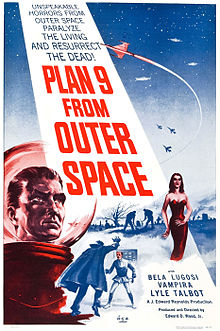
Back Kultusrolprent Afrikaans فيلم كالت Arabic Película de cultu AST Kult film Azerbaijani Культавы фільм Byelorussian Култов филм Bulgarian Pel·lícula de culte Catalan فیلمی چاند CKB Kultovní film Czech Kultfilm Danish

A cult film or cult movie, also commonly referred to as a cult classic, is a film that has acquired a cult following. Cult films are known for their dedicated, passionate fanbase, which forms an elaborate subculture, members of which engage in repeated viewings, dialogue-quoting, and audience participation. Inclusive definitions allow for major studio productions, especially box-office bombs, while exclusive definitions focus more on obscure, transgressive films shunned by the mainstream. The difficulty in defining the term and subjectivity of what qualifies as a cult film mirror classificatory disputes about art. The term cult film itself was first used in the 1970s to describe the culture that surrounded underground films and midnight movies, though cult was in common use in film analysis for decades prior to that.
Cult films trace their origin back to controversial and suppressed films kept alive by dedicated fans. In some cases, reclaimed or rediscovered films have acquired cult followings decades after their original release, occasionally for their camp value. Other cult films have since become well-respected or reassessed as classics; there is debate as to whether these popular and accepted films are still cult films. After failing at the cinema, some cult films have become regular fixtures on cable television or profitable sellers on home video. Others have inspired their own film festivals. Cult films can both appeal to specific subcultures and form their own subcultures. Other media that reference cult films can easily identify which demographics they desire to attract and offer savvy fans an opportunity to demonstrate their knowledge.
Cult films frequently break cultural taboos, and many feature excessive displays of violence, gore, sexuality, profanity, or combinations thereof. This can lead to controversy, censorship, and outright bans; less transgressive films may attract similar amounts of controversy when critics call them frivolous or incompetent. Films that fail to attract requisite amounts of controversy may face resistance when labeled as cult films. Mainstream films and big budget blockbusters have attracted cult followings similar to more underground and lesser known films; fans of these films often emphasize the films' niche appeal and reject the more popular aspects. Fans who like the films for the wrong reasons, such as perceived elements that represent mainstream appeal and marketing, will often be ostracized or ridiculed. Likewise, fans who stray from accepted subcultural scripts may experience similar rejection.
Since the late 1970s, cult films have become increasingly popular. Films that once would have been limited to obscure cult followings are now capable of breaking into the mainstream, and showings of cult films have proved to be a profitable business venture. Overly broad usage of the term has resulted in controversy, as purists state it has become a meaningless descriptor applied to any film that is the slightest bit weird or unconventional; others accuse Hollywood studios of trying to artificially create cult films or use the term as a marketing tactic. Modern films are frequently stated to be an "instant cult classic", occasionally before they are released. Some films have acquired massive, quick cult followings, owing to advertisements and posts made by fans spreading virally through social media. Easy access to cult films via video on demand and peer-to-peer file sharing has led some critics to pronounce the death of cult films.